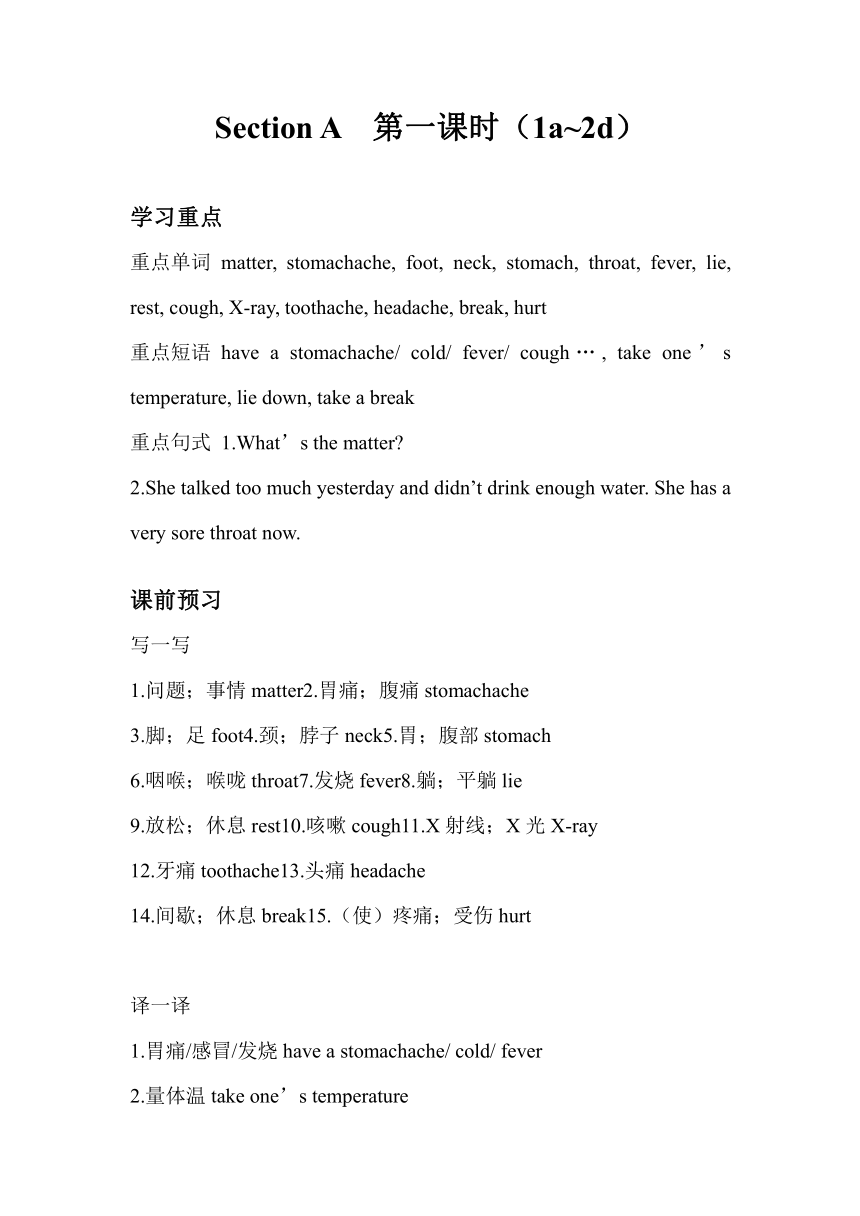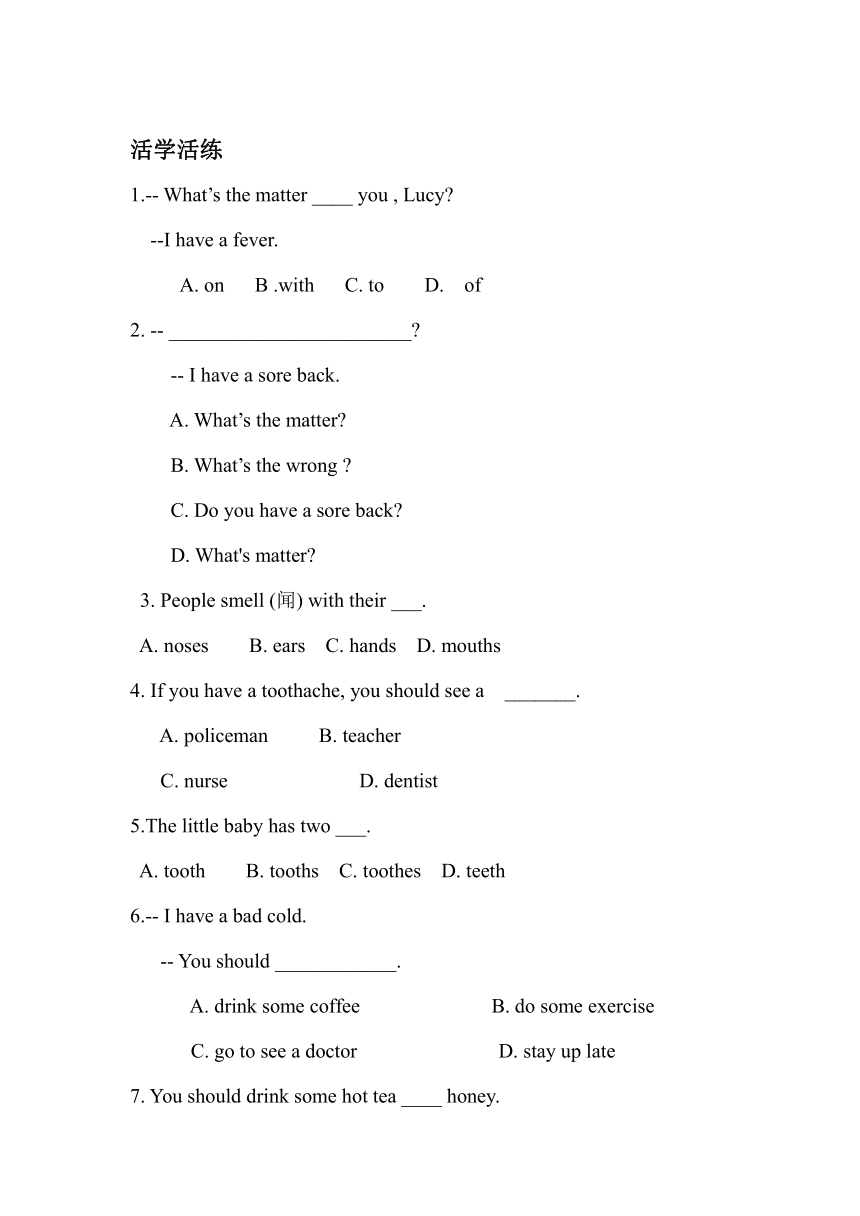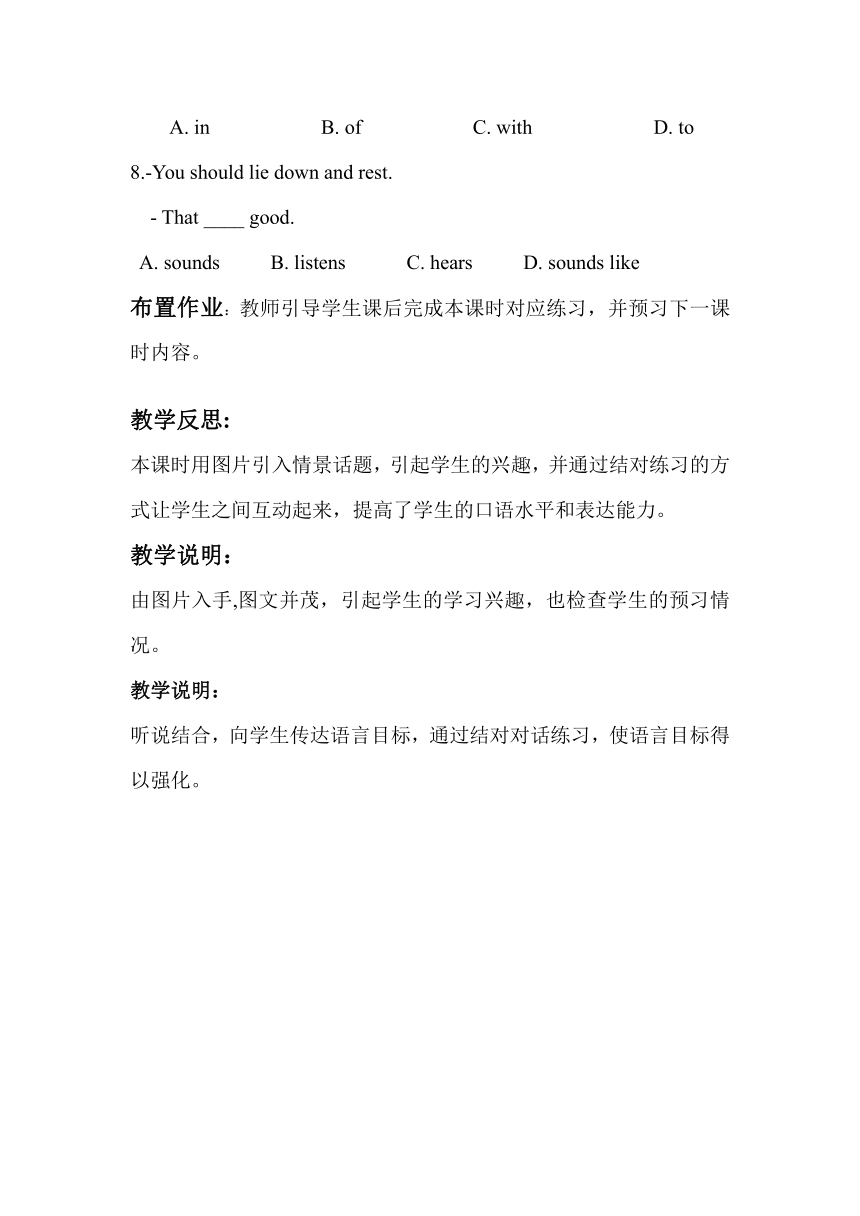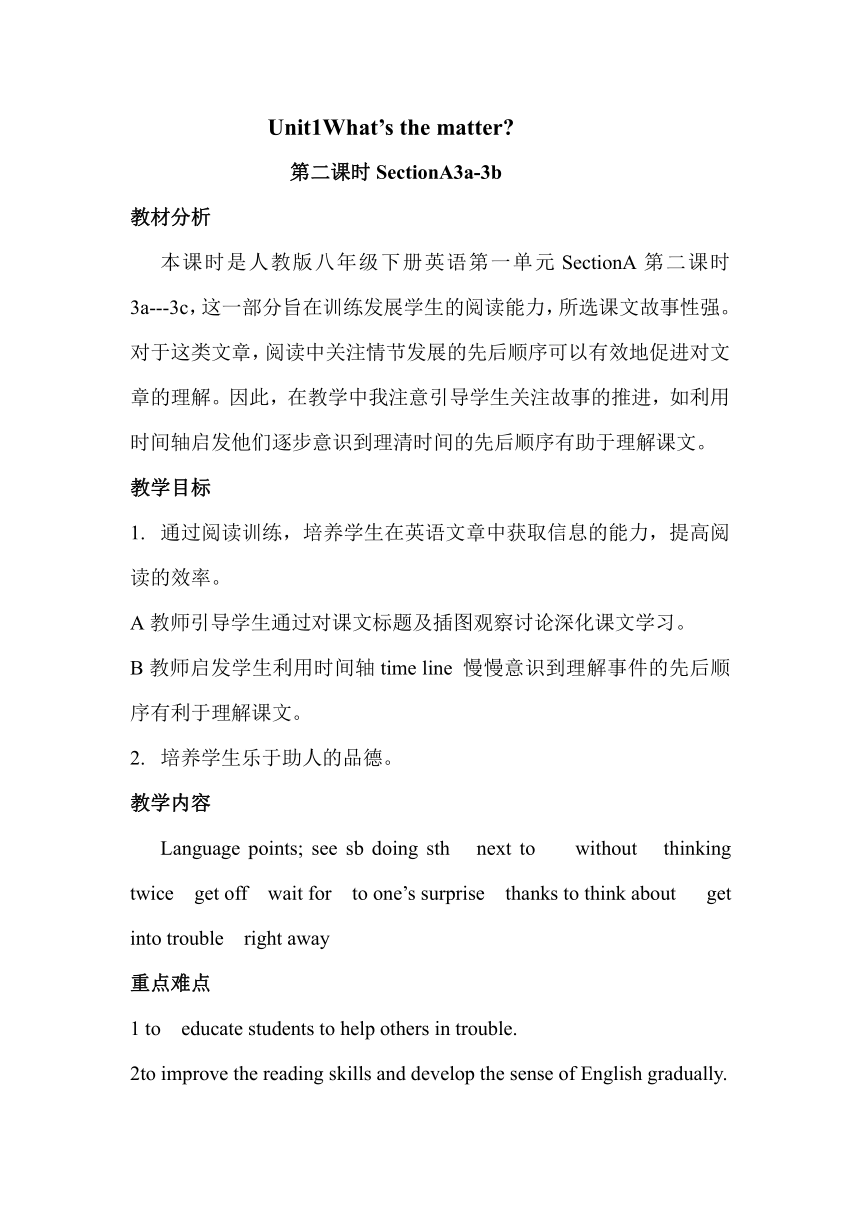Unit 1 What's the matter?-SectionA教案(共5课时)
文档属性
| 名称 | Unit 1 What's the matter?-SectionA教案(共5课时) |

|
|
| 格式 | zip | ||
| 文件大小 | 30.5KB | ||
| 资源类型 | 教案 | ||
| 版本资源 | 人教新目标(Go for it)版 | ||
| 科目 | 英语 | ||
| 更新时间 | 2022-03-02 16:00:34 | ||
图片预览





文档简介
Section A 第一课时(1a~2d)
学习重点
重点单词 matter, stomachache, foot, neck, stomach, throat, fever, lie, rest, cough, X-ray, toothache, headache, break, hurt
重点短语 have a stomachache/ cold/ fever/ cough…, take one’s temperature, lie down, take a break
重点句式 1.What’s the matter
2.She talked too much yesterday and didn’t drink enough water. She has a very sore throat now.
课前预习
写一写
1.问题;事情matter2.胃痛;腹痛stomachache
3.脚;足foot4.颈;脖子neck5.胃;腹部stomach
6.咽喉;喉咙throat7.发烧fever8.躺;平躺lie
9.放松;休息rest10.咳嗽cough11.X射线;X光X-ray
12.牙痛toothache13.头痛headache
14.间歇;休息break15.(使)疼痛;受伤hurt
译一译
1.胃痛/感冒/发烧have a stomachache/ cold/ fever
2.量体温take one’s temperature
3.躺下lie down4.休息take a break(take breaks)
新课导入
Teacher: Good morning boys and girls. We are going to learn Unit1 SectionA. What’s the matter Now, let’s start the class. (Show some pictures)Look at the boy. Can you name the parts of his body
Student A: hand……
Student B: hair……
新课展示
【完成教材1a~1c的任务】
1.学生朗读1a中的单词,教师纠正错误读音,然后学生识记单词并将单词和身体部位对应识记。
2.让学生仔细观察1a图片中的人物,然后认真听录音,完成课本上1b的听力任务并跟读。
【完成教材2a~2b的任务】
Teacher: If you have health problems, what should you do Now, listen to the text and find the answer. Then number the picture 1-5 in order you hear.
1.认真观察2a图片,按听到的对话顺序给图片标号,集体核对答案。
2.认真阅读2b中的单词和短语,再听一遍录音,将问题和建议匹配,完成后集体核对答案,并让学生跟读一遍。
3.让学生利用2a、2b中的信息仿照2c的形式练习对话
【问题探究】
活学活练
1.-- What’s the matter ____ you , Lucy
--I have a fever.
A. on B .with C. to D. of
2. -- ________________________
-- I have a sore back.
A. What’s the matter
B. What’s the wrong
C. Do you have a sore back
D. What's matter
3. People smell (闻) with their ___.
A. noses B. ears C. hands D. mouths
4. If you have a toothache, you should see a _______.
A. policeman B. teacher
C. nurse D. dentist
5.The little baby has two ___.
A. tooth B. tooths C. toothes D. teeth
6.-- I have a bad cold.
-- You should ____________.
A. drink some coffee B. do some exercise
C. go to see a doctor D. stay up late
7. You should drink some hot tea ____ honey.
A. in B. of C. with D. to
8.-You should lie down and rest.
- That ____ good.
A. sounds B. listens C. hears D. sounds like
布置作业:教师引导学生课后完成本课时对应练习,并预习下一课时内容。
教学反思:
本课时用图片引入情景话题,引起学生的兴趣,并通过结对练习的方式让学生之间互动起来,提高了学生的口语水平和表达能力。
教学说明:
由图片入手,图文并茂,引起学生的学习兴趣,也检查学生的预习情况。
教学说明:
听说结合,向学生传达语言目标,通过结对对话练习,使语言目标得以强化。
Unit1What’s the matter
第二课时SectionA3a-3b
教材分析
本课时是人教版八年级下册英语第一单元SectionA第二课时3a---3c,这一部分旨在训练发展学生的阅读能力,所选课文故事性强。对于这类文章,阅读中关注情节发展的先后顺序可以有效地促进对文章的理解。因此,在教学中我注意引导学生关注故事的推进,如利用时间轴启发他们逐步意识到理清时间的先后顺序有助于理解课文。
教学目标
1. 通过阅读训练,培养学生在英语文章中获取信息的能力,提高阅读的效率。
A教师引导学生通过对课文标题及插图观察讨论深化课文学习。
B教师启发学生利用时间轴time line 慢慢意识到理解事件的先后顺序有利于理解课文。
2. 培养学生乐于助人的品德。
教学内容
Language points; see sb doing sth next to without thinking twice get off wait for to one’s surprise thanks to think about get into trouble right away
重点难点
1 to educate students to help others in trouble.
2to improve the reading skills and develop the sense of English gradually.
学情分析
本班学生来自农村,基础薄弱,阅读能力较差,见识面窄。缺乏自信,课堂上不能积极活跃地回答问题。但他们学习态度认真,能够按老师要求完成指定任务。
教学准备
Computer blackboard,ppt,录音机
教学过程
Step1 Greeting and review
Play the game 教师准备四张英文卡片关于疾病的词汇,让四位学生登台表演 other students ask and answer like this;
What’s wrong with him/her?
He has a toothache / sore throat /headache
What should he/she do
Step2 Lead-in
Students look at the picture and guess
What might happen
Step3 Reading
Before- reading
教师引导学生利用标题和插图回答问题并展示PPT
What happened to the man lying on the road
What was the person next to him doing
Did this man die
Who do you think is going to save the man
Do you think this article comes from a newspaper or a book
While –reading
1教师利用多媒体教学课件呈现以下时间轴学生再次读课文,按顺序填出相关情节
________↓__________↓_____________↓______________↓_
Something happened bus driver’s passenger’s result
at9:00a.m.yesterday reaction reaction
2学生按照3b活动要求就课文细节进行判断并核对答案。
After-reading
1 Discussion the questions 3c in groups
2语言学习 三位学生上黑板写出相关词汇
与Bus 相关的表述:
与医疗急救相关的表达:
其他值得学习的词汇:
Step4 Exercise.
教学反思:
本节课讲的是Unit1what’s the matter 的第二课时阅读课。在教学中我通过复习what’s the matter with the man What should we do?we should take him to the hospital导入。接着通过课文插图和标题猜测短文的大意和类型,然后出示阅读指导,细读课文完成True or False和3b,利用时间轴引导学生概述各时间段所发生的事,把故事情节按照时间先后顺序连贯起来概括短文大意。After reading 指导学生联系自己就一些问题和观点进行讨论并指出We should help others in troubles对学生进行思品渗透。同时教师对本节课的重点词汇辅导与总结。
本节课重在阅读策略的指导、阅读技能技巧的不断提高,电教多媒体地运用提高了学生学习兴趣,但由于容量比较大,学生基础较差,后面时间有点紧。
总之,我认为成功的课需多动脑,勤钻研,所以在今后的教学中应多研究教材、研究学生,在短期内取得更大进步。
Unit 1 What’s the matter
Section A (3a—3c)
一、教学目标:
1. 语言知识目标:
1) 单词:passenger, off, get off, to one’s surprise onto, trouble, hit, right away, get into
2)短语:agree to do sth, thanks to, in time, get into trouble
3)句型:
① The bus driver, 24-year-old Wang Ping, stopped the bus without thinking twice.
② He expected most or all of the passengers to get off and wait for the next bus.
③ To his surprise, they all agreed to go with him.
2.能力目标: 熟读文章;复述课文,用一般过去时态描述事件。
3. 情感态度价值观目标:
面对有些人“多一事不如少一事”的消极观点,我们应该在尽量保护自已的同时,能为他人为社会献出一点爱,这世界会变成美好的人间。
二、教学重难点
1. 教学重点:
1) 学习一些重要的字词短语。
2) 学习本课时出现的重点句型,通过叙述课文来熟练运用一般过去时态。
2. 教学难点:用一般过去时态复述课文。
三、教学方法
四步教学法 :自主学习 和谐互助课堂
四.教学过程
通过小品《扶不扶》里乐于助人的郝建,导入新课。使学生对帮不帮别人有个初步认识。
Ⅰ. 自学检测(解决上节课预习提纲,;同学互助纠错,发现问题,解决问题。初步认识本课基本单词,短语)
1. 预习课本P3新单词并背诵,完成下面的汉译英。
1).乘客 _________________ 2)问题___________________
2. 认真预习3a-3c, 找出下列短语和句型。
1)下车__________ 2)使……惊讶的是______________3)同意(做某事)___________
4)幸亏___________ 5)及时_____________6)立刻___________7)造成麻烦___________
8)毫不犹豫地_________9)看见…做…___________10)希望……做……___________
Ⅱ. 合作探究(以小组讨论为主)
(一)3a Read the passage in a group.(1.认识单词短语句子,达到流利阅读的要求;2.回答书上初读的两个问题;3.写出故事纲要,整体了解文章)
1.Students read the passage by themselves. Then choose some to read for others.At last, they read together.
2. Answer the questions.
Do you think it comes from a newspaper or a book How do you know
3. Write the outline.
(二)Read the passage again.(通过第二次阅读短文,了解具体信息,完成黑板纲要,使学生在口语表达中学会英语知识点,从而达到德育教育,并巩固难点词用法)
Find these words and discuss in a group.
1.see sb (do )
2.介词(prep) + doing/n./pron.
3. surprise(____________; __________)
4.trouble (_____________; __________; ____________)
5.right away=....
6.expect
7.oneself
8.thanks to/thanks for
9.stop to do/doing
Finish the outline.
(三)Read the passage again.(通过上面环节,学生已经对文章内容有所了解,让学生讨论完成书上3a 及3b的内容.)
1. 3b
2. 3c
Ⅲ. 巩固提升 (小组合作完成语言综合运用)
1. Retell the story in a group, then four students retell the story together.
2. Do some exercises.
Ⅳ. 课外延伸(对本节课所学内容进行回顾,总结。并对下节课布置预习任务)
(一.)What did you learn this class
(二.)Homework(预习提纲)
1.预习课本P4新单词并背诵,完成下面的汉译英。
(1)她自己____________
2.认真预习 Grammar Focus-4c 找出下列短语和句型。
(1)摔倒_______
(2)你发烧了吗?______________
(3)下次你不应该吃如此多____________________
(4)你应该躺下休息__________________
(5)他应该看牙医并且拍个X光片_________________________________
(6)——我应该在上面敷一些药吗?——是的,应该。
_________________________________________________
Ⅴ 板书设计:(板书内容为故事纲要,学生能通过板书了解整篇文章,并了解重点词汇)
Unit 1 What’s the matter (3a-3c)
Bus Driver and Passengers Save an Old Man
Time: at 9:oo a.m. yesterday
Place: Zhongshan Road
Persons:1. The old man:lay on ....; had a heart problem.
2. A woman: shout for help
3. The bus driver: 24; stopped...; got off; asked....; told...; expected....
4. The passengers: agreed to go with him; helped Mr Wang to move...
Result: The old man was saved.
Unit1 What’s the matter
Section A 3a--3c
教学目标:
1.知识与能力
知识目标:
The vocabulary:
passenger, trouble, herself, get off, to one’s surprise, agree to, get into trouble
Target language:
The driver saw an old man lying on the side of the road.
The bus driver stopped the bus without thinking twice.
Thanks to Mr.Wang and the passengers, the doctors saved the man in time.
能力目标:
Master the skills of reading.
Master the important phrases
2.过程与方法
运用图片展示进行复习,通过播放视频进行导入,运用框架结构讲解文章,实现有效阅读。通过个人小组的教学活动,让全体学生参与到课堂教学中,充分发挥学生的主体作用。
3.情感态度与价值观
(1)体验合作学习与分享的快乐,提高学生的英语学习兴趣和自信心。
(2)懂得在危急时刻,不能袖手旁观,应该乐于助人。
学情分析:
八年级学生有了一定的语言基础,谈论“健康问题”话题,贴近生活实际,易于表达,学生学习热情较高。难点在于本节课是阅读课,学生对于阅读的技巧还存在很大问题,计划从学生擅长且易于达成的活动入手,并结合思维导图帮助学生构建阅读框架与线索,不同难度的问题采取不同的学习方式,意在于让每个学生都觉得有收获,从而树立阅读的信心
重难点
重点:(1)掌握重点单词及用法;
(2)能根据标题、图示和思维导图抓住文中主要信息;
难点:有效运用阅读策略理解全文。
。
教学过程:
一.Warm-up
Have a revision. Let students look at the pictures on the board to have a free-talk and review the key points by talking about healthy problems.
二. Lead-in
Let students watching a video and show a picture about the passage to lead in the passage.
三. Preparation
Let students learn the new words and phrases by showing the pictures and making sentences to help remember them.
四. Fast-Reading
Give students 1minutes to look through the whole passage quickly and then answer the questions.
五.Careful-Reading
Give students 3minutes to read the passage loudly and carefully. Let them find out the meaning of each sentence.
Use the frame to help them understand the passage.
Finish the task of 3b.
六. Last-Reading
Let students pay more attention to the phrases and language points.
Work in groups to discuss the questions in 3c and choose a reporter to answer the question.
七.Translation and Competition
Let students work in groups to compete with each other.
八. Summary
Let students do the summary together
Unit1What’s the matter
(SectionA 1a—1c)
Ⅰ. Teaching aims and demands.
1. Learning English name of body parts of expression way.
2. Learn how to express the body of uncomfortable.
3. For others to various body unwell appropriate advice.
Ⅱ. Teaching importance and difficulty.
Talk about your health.
Ⅲ. Teaching ways .
Revision、Learning、Practice and Reading.
Ⅳ. Teaching tools .
A tape recorder、Music 、A projector( Multimedia)、
Pictures for teaching the names of the body.
Ⅴ. Teaching time: One period
Ⅵ. Teaching procedure.
1. Knowledge Objects.
Body names and illness.
What’s the matter
I have a cold.
2. Ability Objects.
Listening skill.
Recognizing skill.
3. Moral Objects.
Do exercise every day and keep healthy and strong.
Ⅶ. Teaching Methods.
Recognizing method.Listening method.
Discover method. Pairwork.
Ⅷ Blackboard Design.
Unit 2 What’s the matter
Tooth ——teeth(pl.) Foot ——feet(pl.)
Toothache Stom-ach-ache Eye ear mouth nose
Ⅸ.Teaching procedures.
Step1 Warming-up (song).
Get the students ready for the class.
Step2 Greet the class.
Show the teaching goals and request.
Task 1 Parts of the body.
Step 3 Presentation ( 1a ).
1. Students look at the pictures on the big screen and learn the new
2.Show new words.words about the parts of the body.
3. Listen to “Body song”, see who can write down the most words about
“parts of the body”. And answer the questions:
1).How many words can you hear 2).What are they
4.Activity 1a ,Look at SectionA-1a on the big screen. listen and repeat
new words write the correct letter[a—m] for each part of the body. They
do it together and then check the answers with the whole class
5. A game: Touch your …… Boys PK girls.
The last one to stay here is the winner.
Task 2 What’s the matter .
Act out and show the pictures of illness on the big screen. Then show the other new words on the big screen. Read the new words to students and ask them to repeat. Make sure every student knows the meaning and can read them. Read 1a conversations.
Step4 Having a problem .
1 Show the students six pictures and get them to work in groups .
I have a ~ache. I have a sore back.
A: What’s the matter with… B: I have a cold or a fever.
A: What’s the matter B: She/He has…
Step 5 Listening to comprehension (1b , 1c).
1. For activity1b , the students listen and look at the picture, then number the names 1-5.
2. Play the tape, the students listen and number.
3. Check the answers with the whole class.
4. Pairwork 1c, the students look at the picture and make
conversations.
Teach students more words of illness.
For example: Have a cold have a fever have a sore back
have a sore throat headache stomachache toothache
Step 6 Consolidation
Let’s play a game: What’s the matter
Task 3 Give advice.
If I have…,what should I do
You should do sth .
You shouldn’t do sth.
Step7 Grammar Focus
1.What’s the matter with sb = What’s the trouble with sb
= What’s wrong with sb
2. have a + “名词” “得……病”.
Eg: have a cold/fever/headache/sore back
3.Should是情态动词,没有人称和数的变化。
should +动词原形 “应该….”
Eg: You should see a doctor. should + not =shouldn’t “不应该….”
Eg: You shouldn’t go to the party.
Step 8 Pairwork:
show seven pictures . One student acts as a doctor, the
others act as patients.Four or more students in a groups.
Step 10 Homework.
Write down the names of the body parts and illnesses you know.
学习重点
重点单词 matter, stomachache, foot, neck, stomach, throat, fever, lie, rest, cough, X-ray, toothache, headache, break, hurt
重点短语 have a stomachache/ cold/ fever/ cough…, take one’s temperature, lie down, take a break
重点句式 1.What’s the matter
2.She talked too much yesterday and didn’t drink enough water. She has a very sore throat now.
课前预习
写一写
1.问题;事情matter2.胃痛;腹痛stomachache
3.脚;足foot4.颈;脖子neck5.胃;腹部stomach
6.咽喉;喉咙throat7.发烧fever8.躺;平躺lie
9.放松;休息rest10.咳嗽cough11.X射线;X光X-ray
12.牙痛toothache13.头痛headache
14.间歇;休息break15.(使)疼痛;受伤hurt
译一译
1.胃痛/感冒/发烧have a stomachache/ cold/ fever
2.量体温take one’s temperature
3.躺下lie down4.休息take a break(take breaks)
新课导入
Teacher: Good morning boys and girls. We are going to learn Unit1 SectionA. What’s the matter Now, let’s start the class. (Show some pictures)Look at the boy. Can you name the parts of his body
Student A: hand……
Student B: hair……
新课展示
【完成教材1a~1c的任务】
1.学生朗读1a中的单词,教师纠正错误读音,然后学生识记单词并将单词和身体部位对应识记。
2.让学生仔细观察1a图片中的人物,然后认真听录音,完成课本上1b的听力任务并跟读。
【完成教材2a~2b的任务】
Teacher: If you have health problems, what should you do Now, listen to the text and find the answer. Then number the picture 1-5 in order you hear.
1.认真观察2a图片,按听到的对话顺序给图片标号,集体核对答案。
2.认真阅读2b中的单词和短语,再听一遍录音,将问题和建议匹配,完成后集体核对答案,并让学生跟读一遍。
3.让学生利用2a、2b中的信息仿照2c的形式练习对话
【问题探究】
活学活练
1.-- What’s the matter ____ you , Lucy
--I have a fever.
A. on B .with C. to D. of
2. -- ________________________
-- I have a sore back.
A. What’s the matter
B. What’s the wrong
C. Do you have a sore back
D. What's matter
3. People smell (闻) with their ___.
A. noses B. ears C. hands D. mouths
4. If you have a toothache, you should see a _______.
A. policeman B. teacher
C. nurse D. dentist
5.The little baby has two ___.
A. tooth B. tooths C. toothes D. teeth
6.-- I have a bad cold.
-- You should ____________.
A. drink some coffee B. do some exercise
C. go to see a doctor D. stay up late
7. You should drink some hot tea ____ honey.
A. in B. of C. with D. to
8.-You should lie down and rest.
- That ____ good.
A. sounds B. listens C. hears D. sounds like
布置作业:教师引导学生课后完成本课时对应练习,并预习下一课时内容。
教学反思:
本课时用图片引入情景话题,引起学生的兴趣,并通过结对练习的方式让学生之间互动起来,提高了学生的口语水平和表达能力。
教学说明:
由图片入手,图文并茂,引起学生的学习兴趣,也检查学生的预习情况。
教学说明:
听说结合,向学生传达语言目标,通过结对对话练习,使语言目标得以强化。
Unit1What’s the matter
第二课时SectionA3a-3b
教材分析
本课时是人教版八年级下册英语第一单元SectionA第二课时3a---3c,这一部分旨在训练发展学生的阅读能力,所选课文故事性强。对于这类文章,阅读中关注情节发展的先后顺序可以有效地促进对文章的理解。因此,在教学中我注意引导学生关注故事的推进,如利用时间轴启发他们逐步意识到理清时间的先后顺序有助于理解课文。
教学目标
1. 通过阅读训练,培养学生在英语文章中获取信息的能力,提高阅读的效率。
A教师引导学生通过对课文标题及插图观察讨论深化课文学习。
B教师启发学生利用时间轴time line 慢慢意识到理解事件的先后顺序有利于理解课文。
2. 培养学生乐于助人的品德。
教学内容
Language points; see sb doing sth next to without thinking twice get off wait for to one’s surprise thanks to think about get into trouble right away
重点难点
1 to educate students to help others in trouble.
2to improve the reading skills and develop the sense of English gradually.
学情分析
本班学生来自农村,基础薄弱,阅读能力较差,见识面窄。缺乏自信,课堂上不能积极活跃地回答问题。但他们学习态度认真,能够按老师要求完成指定任务。
教学准备
Computer blackboard,ppt,录音机
教学过程
Step1 Greeting and review
Play the game 教师准备四张英文卡片关于疾病的词汇,让四位学生登台表演 other students ask and answer like this;
What’s wrong with him/her?
He has a toothache / sore throat /headache
What should he/she do
Step2 Lead-in
Students look at the picture and guess
What might happen
Step3 Reading
Before- reading
教师引导学生利用标题和插图回答问题并展示PPT
What happened to the man lying on the road
What was the person next to him doing
Did this man die
Who do you think is going to save the man
Do you think this article comes from a newspaper or a book
While –reading
1教师利用多媒体教学课件呈现以下时间轴学生再次读课文,按顺序填出相关情节
________↓__________↓_____________↓______________↓_
Something happened bus driver’s passenger’s result
at9:00a.m.yesterday reaction reaction
2学生按照3b活动要求就课文细节进行判断并核对答案。
After-reading
1 Discussion the questions 3c in groups
2语言学习 三位学生上黑板写出相关词汇
与Bus 相关的表述:
与医疗急救相关的表达:
其他值得学习的词汇:
Step4 Exercise.
教学反思:
本节课讲的是Unit1what’s the matter 的第二课时阅读课。在教学中我通过复习what’s the matter with the man What should we do?we should take him to the hospital导入。接着通过课文插图和标题猜测短文的大意和类型,然后出示阅读指导,细读课文完成True or False和3b,利用时间轴引导学生概述各时间段所发生的事,把故事情节按照时间先后顺序连贯起来概括短文大意。After reading 指导学生联系自己就一些问题和观点进行讨论并指出We should help others in troubles对学生进行思品渗透。同时教师对本节课的重点词汇辅导与总结。
本节课重在阅读策略的指导、阅读技能技巧的不断提高,电教多媒体地运用提高了学生学习兴趣,但由于容量比较大,学生基础较差,后面时间有点紧。
总之,我认为成功的课需多动脑,勤钻研,所以在今后的教学中应多研究教材、研究学生,在短期内取得更大进步。
Unit 1 What’s the matter
Section A (3a—3c)
一、教学目标:
1. 语言知识目标:
1) 单词:passenger, off, get off, to one’s surprise onto, trouble, hit, right away, get into
2)短语:agree to do sth, thanks to, in time, get into trouble
3)句型:
① The bus driver, 24-year-old Wang Ping, stopped the bus without thinking twice.
② He expected most or all of the passengers to get off and wait for the next bus.
③ To his surprise, they all agreed to go with him.
2.能力目标: 熟读文章;复述课文,用一般过去时态描述事件。
3. 情感态度价值观目标:
面对有些人“多一事不如少一事”的消极观点,我们应该在尽量保护自已的同时,能为他人为社会献出一点爱,这世界会变成美好的人间。
二、教学重难点
1. 教学重点:
1) 学习一些重要的字词短语。
2) 学习本课时出现的重点句型,通过叙述课文来熟练运用一般过去时态。
2. 教学难点:用一般过去时态复述课文。
三、教学方法
四步教学法 :自主学习 和谐互助课堂
四.教学过程
通过小品《扶不扶》里乐于助人的郝建,导入新课。使学生对帮不帮别人有个初步认识。
Ⅰ. 自学检测(解决上节课预习提纲,;同学互助纠错,发现问题,解决问题。初步认识本课基本单词,短语)
1. 预习课本P3新单词并背诵,完成下面的汉译英。
1).乘客 _________________ 2)问题___________________
2. 认真预习3a-3c, 找出下列短语和句型。
1)下车__________ 2)使……惊讶的是______________3)同意(做某事)___________
4)幸亏___________ 5)及时_____________6)立刻___________7)造成麻烦___________
8)毫不犹豫地_________9)看见…做…___________10)希望……做……___________
Ⅱ. 合作探究(以小组讨论为主)
(一)3a Read the passage in a group.(1.认识单词短语句子,达到流利阅读的要求;2.回答书上初读的两个问题;3.写出故事纲要,整体了解文章)
1.Students read the passage by themselves. Then choose some to read for others.At last, they read together.
2. Answer the questions.
Do you think it comes from a newspaper or a book How do you know
3. Write the outline.
(二)Read the passage again.(通过第二次阅读短文,了解具体信息,完成黑板纲要,使学生在口语表达中学会英语知识点,从而达到德育教育,并巩固难点词用法)
Find these words and discuss in a group.
1.see sb (do )
2.介词(prep) + doing/n./pron.
3. surprise(____________; __________)
4.trouble (_____________; __________; ____________)
5.right away=....
6.expect
7.oneself
8.thanks to/thanks for
9.stop to do/doing
Finish the outline.
(三)Read the passage again.(通过上面环节,学生已经对文章内容有所了解,让学生讨论完成书上3a 及3b的内容.)
1. 3b
2. 3c
Ⅲ. 巩固提升 (小组合作完成语言综合运用)
1. Retell the story in a group, then four students retell the story together.
2. Do some exercises.
Ⅳ. 课外延伸(对本节课所学内容进行回顾,总结。并对下节课布置预习任务)
(一.)What did you learn this class
(二.)Homework(预习提纲)
1.预习课本P4新单词并背诵,完成下面的汉译英。
(1)她自己____________
2.认真预习 Grammar Focus-4c 找出下列短语和句型。
(1)摔倒_______
(2)你发烧了吗?______________
(3)下次你不应该吃如此多____________________
(4)你应该躺下休息__________________
(5)他应该看牙医并且拍个X光片_________________________________
(6)——我应该在上面敷一些药吗?——是的,应该。
_________________________________________________
Ⅴ 板书设计:(板书内容为故事纲要,学生能通过板书了解整篇文章,并了解重点词汇)
Unit 1 What’s the matter (3a-3c)
Bus Driver and Passengers Save an Old Man
Time: at 9:oo a.m. yesterday
Place: Zhongshan Road
Persons:1. The old man:lay on ....; had a heart problem.
2. A woman: shout for help
3. The bus driver: 24; stopped...; got off; asked....; told...; expected....
4. The passengers: agreed to go with him; helped Mr Wang to move...
Result: The old man was saved.
Unit1 What’s the matter
Section A 3a--3c
教学目标:
1.知识与能力
知识目标:
The vocabulary:
passenger, trouble, herself, get off, to one’s surprise, agree to, get into trouble
Target language:
The driver saw an old man lying on the side of the road.
The bus driver stopped the bus without thinking twice.
Thanks to Mr.Wang and the passengers, the doctors saved the man in time.
能力目标:
Master the skills of reading.
Master the important phrases
2.过程与方法
运用图片展示进行复习,通过播放视频进行导入,运用框架结构讲解文章,实现有效阅读。通过个人小组的教学活动,让全体学生参与到课堂教学中,充分发挥学生的主体作用。
3.情感态度与价值观
(1)体验合作学习与分享的快乐,提高学生的英语学习兴趣和自信心。
(2)懂得在危急时刻,不能袖手旁观,应该乐于助人。
学情分析:
八年级学生有了一定的语言基础,谈论“健康问题”话题,贴近生活实际,易于表达,学生学习热情较高。难点在于本节课是阅读课,学生对于阅读的技巧还存在很大问题,计划从学生擅长且易于达成的活动入手,并结合思维导图帮助学生构建阅读框架与线索,不同难度的问题采取不同的学习方式,意在于让每个学生都觉得有收获,从而树立阅读的信心
重难点
重点:(1)掌握重点单词及用法;
(2)能根据标题、图示和思维导图抓住文中主要信息;
难点:有效运用阅读策略理解全文。
。
教学过程:
一.Warm-up
Have a revision. Let students look at the pictures on the board to have a free-talk and review the key points by talking about healthy problems.
二. Lead-in
Let students watching a video and show a picture about the passage to lead in the passage.
三. Preparation
Let students learn the new words and phrases by showing the pictures and making sentences to help remember them.
四. Fast-Reading
Give students 1minutes to look through the whole passage quickly and then answer the questions.
五.Careful-Reading
Give students 3minutes to read the passage loudly and carefully. Let them find out the meaning of each sentence.
Use the frame to help them understand the passage.
Finish the task of 3b.
六. Last-Reading
Let students pay more attention to the phrases and language points.
Work in groups to discuss the questions in 3c and choose a reporter to answer the question.
七.Translation and Competition
Let students work in groups to compete with each other.
八. Summary
Let students do the summary together
Unit1What’s the matter
(SectionA 1a—1c)
Ⅰ. Teaching aims and demands.
1. Learning English name of body parts of expression way.
2. Learn how to express the body of uncomfortable.
3. For others to various body unwell appropriate advice.
Ⅱ. Teaching importance and difficulty.
Talk about your health.
Ⅲ. Teaching ways .
Revision、Learning、Practice and Reading.
Ⅳ. Teaching tools .
A tape recorder、Music 、A projector( Multimedia)、
Pictures for teaching the names of the body.
Ⅴ. Teaching time: One period
Ⅵ. Teaching procedure.
1. Knowledge Objects.
Body names and illness.
What’s the matter
I have a cold.
2. Ability Objects.
Listening skill.
Recognizing skill.
3. Moral Objects.
Do exercise every day and keep healthy and strong.
Ⅶ. Teaching Methods.
Recognizing method.Listening method.
Discover method. Pairwork.
Ⅷ Blackboard Design.
Unit 2 What’s the matter
Tooth ——teeth(pl.) Foot ——feet(pl.)
Toothache Stom-ach-ache Eye ear mouth nose
Ⅸ.Teaching procedures.
Step1 Warming-up (song).
Get the students ready for the class.
Step2 Greet the class.
Show the teaching goals and request.
Task 1 Parts of the body.
Step 3 Presentation ( 1a ).
1. Students look at the pictures on the big screen and learn the new
2.Show new words.words about the parts of the body.
3. Listen to “Body song”, see who can write down the most words about
“parts of the body”. And answer the questions:
1).How many words can you hear 2).What are they
4.Activity 1a ,Look at SectionA-1a on the big screen. listen and repeat
new words write the correct letter[a—m] for each part of the body. They
do it together and then check the answers with the whole class
5. A game: Touch your …… Boys PK girls.
The last one to stay here is the winner.
Task 2 What’s the matter .
Act out and show the pictures of illness on the big screen. Then show the other new words on the big screen. Read the new words to students and ask them to repeat. Make sure every student knows the meaning and can read them. Read 1a conversations.
Step4 Having a problem .
1 Show the students six pictures and get them to work in groups .
I have a ~ache. I have a sore back.
A: What’s the matter with… B: I have a cold or a fever.
A: What’s the matter B: She/He has…
Step 5 Listening to comprehension (1b , 1c).
1. For activity1b , the students listen and look at the picture, then number the names 1-5.
2. Play the tape, the students listen and number.
3. Check the answers with the whole class.
4. Pairwork 1c, the students look at the picture and make
conversations.
Teach students more words of illness.
For example: Have a cold have a fever have a sore back
have a sore throat headache stomachache toothache
Step 6 Consolidation
Let’s play a game: What’s the matter
Task 3 Give advice.
If I have…,what should I do
You should do sth .
You shouldn’t do sth.
Step7 Grammar Focus
1.What’s the matter with sb = What’s the trouble with sb
= What’s wrong with sb
2. have a + “名词” “得……病”.
Eg: have a cold/fever/headache/sore back
3.Should是情态动词,没有人称和数的变化。
should +动词原形 “应该….”
Eg: You should see a doctor. should + not =shouldn’t “不应该….”
Eg: You shouldn’t go to the party.
Step 8 Pairwork:
show seven pictures . One student acts as a doctor, the
others act as patients.Four or more students in a groups.
Step 10 Homework.
Write down the names of the body parts and illnesses you know.
同课章节目录
- Unit 1 What's the matter?
- Section A
- Section B
- Unit 2 I'll help to clean up the city parks.
- Section A
- Section B
- Unit 3 Could you please clean your room?
- Section A
- Section B
- Unit 4 Why don't you talk to your parents?
- Section A
- Section B
- Unit 5 What were you doing when the rainstorm came
- Section A
- Section B
- Review of Units 1-5
- Unit 6 An old man tried to move the mountains.
- Section A
- Section B
- Unit 7 What's the highest mountain in the world?
- Section A
- Section B
- Unit 8 Have you read Treasure Island yet?
- Section A
- Section B
- Unit 9 Have you ever been to a museum?
- Section A
- Section B
- Unit 10 I've had this bike for three years.
- Section A
- Section B
